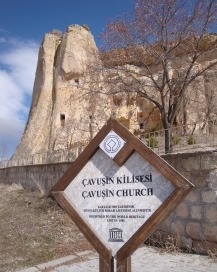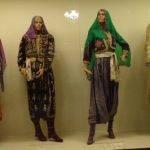The Sergeant’s village Population: Less than 2,000
Until the early 2010s tiny Çavuşin in Cappadocia fell beneath the tourism radar, its inhabitants left to snooze their days away in the sun or toil in the fields as their ancestors had done.
There were always two Çavuşins: the new one running down to the main Avanos-Göreme road, and the old one snuggled into the rocks behind it that was evacuated in the 1950s when local governments decided that it was too dangerous for people to continue to live in the cave houses.
Now even old Çavuşin has been opened up to tourists who pour in by the coachload.
Around town
Çavuşin has two specific attractions, both of them rock-cut churches and both of them, rather confusingly, named after St John the Baptist.
The more obvious of the two is right on the main road at the Avanos end of the village. You can hardly miss it since at some time in the past the wind and rain caused its entire facade to slip away leaving two huge frescoed angels with bright red wings exposed to the outside world. 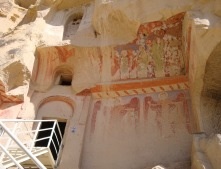
Even with that introduction the interior of the church still comes as a surprise. The whole of the barrel-vaulted room is covered in frescoes in which red and pale green seem to dominate. Only in the apse have the paintings virtually vanished.
Those who know their Bible will be able to pick out the familiar stories of the Nativity, the Last Supper, the Baptism in the River Jordan, the Raising of Lazarus etc but this church is especially known for the images of the Emperor Nicephorus Phocas and his wife in the northern apse. Since these were presumably painted after the Emperor’s visit to Cappadocia they have enabled this church to be dated more precisely than most in the area: to 963-69 in fact.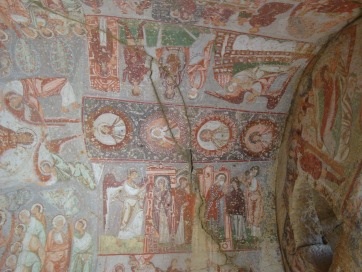
Also interesting are the line-up of soldiers in their uniforms that run along the bottom of the northern wall. These have been identified as some of the Forty Martyrs of Sebaste (Sivas) who were driven onto a frozen lake to die of cold for refusing to abandon their faith.
The second church could hardly be more different. A huge structure, it nonetheless hunkers down in the rockface at the top of the old village; you’ll only recognise it from the outside once you’ve found your way into it. It, too, must once have boasted fabulous paintings but they are now on their last legs, only the ones around the chancel arch surviving to any great extent. Instead what you’ll notice are the stubby pillars cut into the walls as at Selime.
Later, the church was reused as a pigeon-house and you can make out perches for the birds cut into the pillars.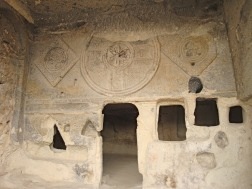
It’s fun to walk around old Çavuşin admiring the ruins of lovely old houses and mourning the building of an inappropriately elaborate hotel right next to them. The small mosque with its simple Cappadocian-style minaret has been restored. And the village itself faces over the valley to a wonderful wall of pigeon-houses.
If you climb up on to the top of the ridge and walk across it you will be able to look across the valley on the other side at a group of fairy chimneys that show their own evolution clearly: first connected to the plateau, then standing alone with protective caps of harder rock, then slowly crumbling away once the cap is gone. If you half-close your eyes you could almost imagine that you’re looking at a group of turbaned Ottomans gathered together for a chat.
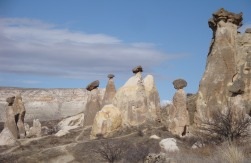 Sleeping
Sleeping
Green Motel, Çavuşin. Tel.: 0384-532 70 50
Turbel Cave Hotel, Çavuşin. Tel.: 0384-532 70 84
Village Cave Hotel, Çavuşin. Tel.: 0384-532 71 97
Transport info
Hourly buses from Nevşehir to Avanos and vice versa pass through Çavuşin, as do two-hourly buses from Avanos to Ürgüp.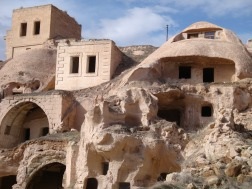
Day trip destinations
The saga of Nicephorus Phocas and Theophano
Poet John Ash’s wonderful travelogue A Byzantine Journey tells the story of the prominent roadside Church of St John the Baptist, known to locals as the Great Pigeon House but also called the Church of Nicephorus Phocas.
In 964 the Byzantine Emperor Nicephorus Phocas paid a visit to Cappadocia, which lay on the frontline between his empire and the encroaching Arab world, and the northern apse of the church is decorated with portraits of the emperor and his lovely but scheming wife Theophano. A picture of a man on horseback may well depict not one of the military saints George, Demetrius and Theodore, who often appear on the walls of Cappadocian churches, but Phocas’ nephew and killer, John Tzimiskes.
Ash described Theophano as “a figure wrapped in the smoke of rumour and slander” who had previously been married to the Emperor Romanus II and had become empress at the age of 18. A few years later her husband died, leaving her regent for a son aged just six. Theophano quickly proposed to Nicephorus Phocas, an ugly but successful Anatolian warrior, but the union turned into a disaster, with Phocas alienating everyone that mattered.
In 969 he was murdered by his dashing young nephew Tzimiskes with whom Theophano is believed to have been in love. Sadly for her, Tzimiskes then bowed to pressure from the Church and, instead of marrying her, exiled her to what is now Büyükada in İstanbul.
